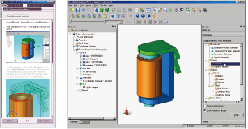JMAG
 JMAG-Designer | |
| Developer(s) | JSOL Corporation |
|---|---|
| Stable release |
Version 17.1
/ 2018-06 |
| Operating system | Cross-platform |
| Type | Finite Element Analysis Simulator |
| Website | jmag-international.com |
JMAG is simulation software for the development and design of electrical devices. JMAG was originally released in 1983 as a tool to support design for devices such as motors, actuators, circuit components, and antennas.
JMAG incorporates simulation technology to accurately analyze a wide range of physical phenomenon that includes complicated geometry, various material properties, and the heat and structure at the center of electromagnetic fields. JMAG has an interface capable of linking to third-party software and a portion of the JMAG analysis functions can also be executed from many of the major CAD and CAE systems.
JMAG is used actively to analyze designs at a system level that includes drive circuits by utilizing links to power electronic simulators. JMAG is also being used for the development of drive motors for electric vehicles.
History
- 1983 – JMAG Version 1 was developed as 3D static magnetic field analysis software.
- 1986 – JMAG DYN was developed as 3D transient magnetic field analysis software.
- 1994 – JMAG-Works was developed as integrated electromagnetic analysis software with thermal analysis solutions.
- 1998 – JMAG-Studio was developed as an integrated electromagnetic analysis software native to Windows.
- 2000 – Coupled analyses was implemented for control solutions.
- 2002 – JMAG-Designer was developed as an add-on for SolidWorks.
- 2004 – JMAG RT-Solutions was developed for model based development of motor drive systems.
- 2007 – JMAG Motor Template 2 was developed for creating motor templates by specifying basic parameters such as the geometry and the windings.
- 2009 – JMAG Motor Bench and JMAG Transformer Design and Evaluation tools were developed for improving the manufacturing of devices.
- 2018 – JMAG-Express Online was developed for designing and evaluating motor on web browser.
See also
External links
- jmag-international.com, official website